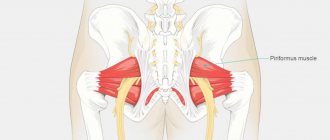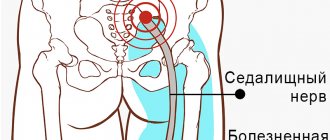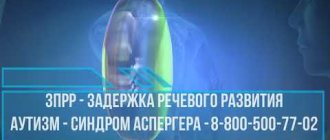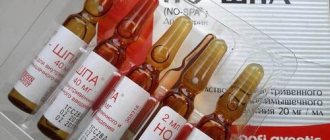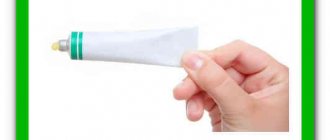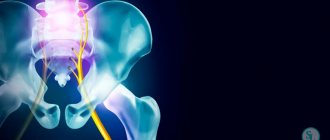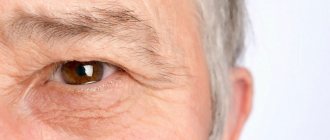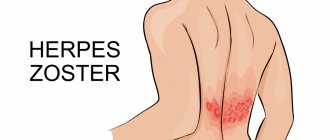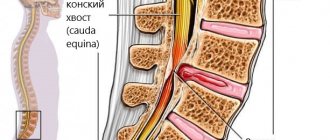What is sciatica
Sciatica (from the Greek ischias - seat) is a disease associated with pinching and inflammation of the sciatic nerve in the lumbosacral spine. Other names for this disease are lumbosacral radiculitis or sciatic neuralgia.
The sciatic nerve is the longest nerve in the body. It originates in the lower back from the nerve roots of the lumbar spinal cord and passes through the gluteal region throughout the lower limb.
An attack of sciatica is usually caused by damage to one or more roots of the lumbosacral spinal cord. But sciatica syndrome can also be caused by pinching of the sciatic nerve as a result of muscle spasm.
Combined
Combined products are ointments that contain two components. One of them is anti-inflammatory, the other is warming. The warming component expands small blood vessels, increasing microcirculation in areas of inflammation. Thanks to this, healing substances quickly penetrate into the painful area and begin their effect.
Using combined ointments, you can relieve severe pain within one to three minutes.
One of the best drugs of this type is Dimexide gel (costs from 200 rubles) . Its active component, dimethyl sulfoxide, has a rapid analgesic effect. It can be applied to the back, and in case of severe pain, applications can be made.
Dimexide gel is an effective pain reliever for severe pain
It happens that in women, inflammation of the sciatic nerve occurs during pregnancy. If this happens, you can use an ointment called Dexpanthenol (price - from 120 rubles). It effectively removes inflammation and relieves pain, and also contains B vitamins, which help improve metabolism and rapid tissue regeneration.
Symptoms of sciatica
The clinical symptoms of sciatica vary. This may be a sharp shooting pain from the lower back to the buttock and down the back of the limb. Often observed:
- acute pain in the buttocks, which intensifies when sitting;
- shooting pain that occurs when trying to stand up;
- numbness or weakness in the leg;
- severe pain when walking or bending over.
With sciatica, pain in the buttock and the back of the thigh, often radiating to the lower leg and foot, is more pronounced than pain in the lower back.
Other symptoms of sciatica include pain in the leg such as burning, tingling, numbness, or pins and needles.
Most often, sciatica affects only one limb, but there are cases when the patient experiences pain in both legs.
The pain with sciatica is usually not as severe as with lumbago. In the initial stages of the disease, the symptoms of sciatica may not be very pronounced. But in advanced cases, such attacks of pain are possible that the patient cannot not only walk, but even stand and sit, and sometimes the pain does not subside even in a lying position and does not allow him to fall asleep.
Folk remedies
How to treat sciatica using folk remedies and when is their use acceptable? Like warming ointments, traditional medicine methods cannot be used in the acute period of the disease. It is best to be treated with home treatments during the remission stage, to prevent subsequent exacerbations.
Prepare a compress from yeast dough. You will need rye flour and water. The dough should be dense. Place it on the lumbar region, covering it with plastic wrap and a towel (to keep warm). The compress should be kept for about an hour, after which you should carefully rub the sore spot with turpentine.
A mixture of beeswax and propolis is an equally well-known folk remedy for the treatment of sciatica. Wax and propolis should be warmed up a little, after making a homogeneous mixture of them. Form the warm mixture into a large patty (about the size of two palms). Apply it to the sore spots, covering with plastic wrap, and keep the compress for an hour or an hour and a half.
Be sure to read: All about spinal blockade: is it dangerous, what is it, types, medications
A compress with beeswax and propolis is a good folk remedy for sciatica.
If you are not allergic to horseradish, take a warm bath with it. Prepare a piece of gauze in advance by wrapping finely grated horseradish in it. The water should not be very hot. Reception time - 60 minutes, course - from one to two weeks.
Conifer baths are one of the best folk remedies. Essential oils and resins have a relaxing effect on muscles and the entire body, calm the nervous system, and have an anti-inflammatory effect. You will need about 1 kg of pine branches. They need to be poured with three liters of boiling water and boiled over medium heat for 15 minutes. The warm infusion is poured into the bath, after filtering and infusing for 4 hours.
Regular stearin also perfectly relieves inflammation and pain. Melt an ordinary household candle and wait until the mass cools down a little. Apply a thin layer of warm stearin to the lumbar region.
When treating sciatica at home, good results are shown by the use of physiotherapeutic devices: Almag-01, Denas, Milta, Vitafon. Due to weak electrical impulses and other technologies, physical devices will help eliminate the symptoms of many diseases of the spine and joints. Depending on the degree of the disease, improvement may occur after 2-3 sessions or a full course of treatment.
Causes of sciatica
The immediate cause of sciatica is irritation or pinching of the sciatic nerve or the nerve roots that form it. But the reasons for this irritation can be different.
The most common cause of sciatica is a herniated disc, which compresses the sciatic nerve roots. Also, irritation of the nerve roots can be caused by osteophytes - bone formations on the joints of the spine that occur with osteochondrosis or spondyloarthrosis.
Spondylolisthesis (displacement of one vertebra relative to another), as well as inflammation and spasm of the lumbar or gluteal muscles (usually the piriformis muscle) can lead to pinching or compression of the nerve roots that form the sciatic nerve.
Attacks of sciatica can also be caused by injuries (including birth), tumors, internal bleeding, diabetes, infectious or gynecological diseases. Therefore, if the symptoms of sciatica are acute or bother you for a long time, you need to consult a doctor and undergo an examination in order to correctly diagnose the disease.
What ointments help with pinched sciatic nerve?
Gels and ointments with analgesic and anti-inflammatory effects are often used to treat sciatica. There are quite a lot of them. What ointments help with pinched sciatic nerve and which one will be better and more effective, a neurologist
. In addition, ointment alone is not enough to treat such a disease. Massage, exercise therapy or other treatment methods may also be required. Therefore, at the first signs of sciatica, you should immediately consult a doctor in order to restore your health as soon as possible.
Finalgon
The active ingredients of Finalgon ointment have analgesic as well as vasodilating properties. In areas of the skin where the ointment is applied, skin hyperemia appears (blood flow to this area increases, resulting in slight redness), the rate of enzymatic reactions increases, and the metabolic process is activated. The analgesic effect of Finalgon appears within a few minutes after application. The maximum effect occurs 20-30 minutes after application. These time frames may be different, depending on the complexity of the disease and the degree of compression of the sciatic nerve.
Flexen
Flexen ointment has analgesic, anti-inflammatory and antipyretic effects. In other words, this ointment can be used in cases where a pinched nerve has led to its inflammation and an increase in the patient’s overall body temperature. The active substances of the ointment have a depressing effect on COX (cyclooxygenases) - enzymes that promote the metabolism of arachidonic acid. In turn, arachidonic acid is a precursor to prostaglandins, which cause inflammation, pain and fever.
Viprosal
One of the active ingredients of Viprosal ointment is viper venom. When applied, the ointment has a local analgesic and irritant effect. Local irritation leads to the activation of sensitive skin receptors of the skin and subcutaneous tissue, blood vessels dilate, and tissue trophism (cellular nutrition) improves.
Carmolis
Carmolis ointment includes a wide list of essential oils (menthol, thyme, anise and others). The list of effects of this ointment is also wide - antimicrobial, antiviral, irritant, antispasmodic, and so on. The ointment can be used as part of complex therapy in the treatment of neurological diseases, including sciatica.
Betalgon
Betalgon is an ointment that has a local irritant, analgesic, and vasodilator effect. When applied, it warms, stimulates local blood circulation, and helps reduce inflammation.
Virapin
Virapin is an ointment with analgesic and anti-inflammatory effects. The ointment contains bee venom.
Naftalgin
Another remedy that can relieve inflammation and eliminate pain when the sciatic nerve is pinched is Naftalgin ointment. Apply to the location of pain or inflammation.
Almost each of the above ointments has a wide list of side effects. These include allergic reactions, dizziness, kidney dysfunction, itchy skin and much more. Consultation with a doctor before using any of the ointments, as well as during its use, is required. If you have a pinched sciatic nerve, you can seek help from the specialists of the Energo clinic. Here, patients undergo a comprehensive examination, their diagnosis is clarified, and other concomitant diseases are identified, which helps to predict the likelihood of some side effects from medications. Our specialists have extensive experience in the treatment of pinched sciatic nerves and are ready to apply it when developing a treatment package in each specific case.
Clinical picture of sciatica
Most often, sciatica develops gradually. At the onset of the disease, slight pain is observed in the lumbar spine and (or) buttocks, as well as a feeling of fatigue and aching legs. But often these symptoms - pain in the lower back, buttocks, fatigue and tension in the legs - are considered overwork.
In the future, the unpleasant sensations may become longer and more intense. But often sciatica in the initial stage continues for quite a long time (up to several years), until a serious exacerbation is caused by some external cause, sometimes quite harmless - a jump, a sharp turn, a fall, heavy lifting, or banal hypothermia. It is with this reason that patients associate the onset of the disease, forgetting about the first symptoms that went unnoticed.
Plasters
This is a more convenient method of treatment compared to ointments: you just need to stick the patches on the affected area and wait for the analgesic effect. Here is a list of the best patches that modern medicine offers:
- Voltaren. This is a patch that contains a non-steroidal anti-inflammatory drug - diclofenac sodium. Voltaren can reduce minor pain and inflammation. Some patients note that the Voltaren patch does not adhere well to the skin. The effect of the patch is 24 hours, the course of treatment is 10-14 days. — from 150 rub.
- Versatis. This anesthetic patch contains lidocaine. Versatis has a good anti-inflammatory effect and relieves pain worse. The patch is effective for 12 hours, the course of treatment is no more than 5 days. — from 800 rub.
Treatment of sciatica
When treating sciatica, it is first important to minimize movement in the affected limb to reduce irritation of the nerve roots. Rest is recommended, the bed should be flat, the legs should be bent at the knee and hip joint and slightly elevated (you need to choose a comfortable position).
In order to relieve pain and inflammation, as well as muscle spasms, analgesics, NSAIDs, and antispasmodics are used. Warming and pain-relieving ointments and gels are prescribed. In the future, physiotherapy, acupuncture, massage and exercise therapy are recommended.
However, modern medicine can offer effective and safe treatment, which can significantly enhance the effect of traditional medications, and in some cases, completely abandon drugs that are unsafe for health. This is a therapeutic anti-inflammatory pain relieving patch NANOPLAST forte.
Treatment of sciatica with therapeutic anti-inflammatory analgesic patch NANOPLAST forte
In the treatment of sciatica, the NANOPLAST forte therapeutic patch has shown high effectiveness. The use of this drug can quickly improve the patient’s condition - reduce pain symptoms, relieve muscle spasms.
Therapeutic pain-relieving anti-inflammatory patch NANOPLAST forte can be used both in the complex treatment of sciatica and as monotherapy. The patch is applied to the lumbar spine and, if necessary, to the gluteal region, depending on the location of the pain. Up to 3 patches can be used at the same time.
In order to get rid of sciatica, you need not only to relieve the pain symptom, but also to improve metabolic processes in the intervertebral discs, remove inflammation, eliminate muscle spasms, improve blood supply and nutrition of nerve endings, stop or at least slow down the development of osteochondrosis. The use of NANOPLAST forte allows you to solve this problem.
Thanks to the simultaneous influence of two physiotherapeutic factors - deep soft warming heat of infrared radiation and the influence of a magnetic field with specially selected characteristics - this innovative drug allows you to relieve pain and inflammation, improve blood circulation in the affected area, and reduce the dose of painkillers and anti-inflammatory drugs.
To relieve acute symptoms in the treatment of sciatica, a therapeutic patch is used for 3 to 5 days. The duration of the course of treatment is from 9 days. It is usually recommended to use the treatment patch in the morning for 12 hours, but it can also be used at night.
High efficiency, unique composition, long-term (up to 12 hours!) therapeutic effects, ease of use and affordable price make NANOPLAST forte the drug of choice in the treatment of sciatica.
The medical patch NANOPLAST forte is sold only in pharmacies.
Read more about NANOPLAST forte
Non-drug treatments
The neurologist prescribes non-drug treatment methods after the patient’s health condition improves. These include:
- massage;
- acupuncture;
- manual therapy;
- a set of therapeutic exercises.
Great article on the topic:
Inflammation of the sciatic nerve (sciatica): TOP 50 methods of quick treatment at home
Steroid medications for treatment
Eliminating the cause of pain during drug treatment of sciatica is the main goal of the disease. To do this, you need to find the place where the nerve is pinched. Acute pain is eliminated using potent blockades with anesthetic drugs. This is carried out in stationary conditions. Then a complex of tablets and other medications is prescribed, which should:
- prevent the appearance of acute pain during a course of treatment;
- reduce the inflammatory process;
- saturate damaged tissues with a sufficient amount of microelements;
- Provide nutrition to the entire body for rapid recovery.
Preventative drug treatment for sciatica is helpful if attacks occur regularly. The drugs used in this case are somewhat different from those prescribed to relieve acute attacks.
The patient is transferred to outpatient therapy when the cause of acute pain is found and home treatment is prescribed. At the same time, a person must move independently.
Steroid drugs are prescribed if other groups of drug treatment have not helped. They relieve inflammation and relieve pinched nerves. Most often prescribed for sciatica are: Prednisone, Dexamethasone, Methylprednisone.
These medications do not affect prostaglandins, but they quickly relieve spasms and swelling, thereby reducing pain. Steroid substances are most often used to inject into the tissue around the injured area.
With regular use or long-term course treatment with steroids, side effects appear: weight increases, osteoporosis develops, stomach ulcers may occur, edema occurs, and blood clotting rates increase.
From this video you will learn how to reduce pain due to inflammation of the sciatic nerve in 10 minutes.
The main advantage of ointments is that they have a targeted effect. At the same time, the likelihood of developing side effects is minimal, since the active component enters the blood in small quantities and is not able to have a negative effect on the body.
Below we briefly describe the main types of ointments for inflammation of the sciatic nerve and their features:
- Homeopathic. Promote biological regulation of the body: improve metabolism, accelerate blood circulation, relieve pain, increase immunity. Disadvantage: slow action.
- Warming. The effect on the inflamed area occurs due to the heat generated. As a result, the pinched muscle relaxes and frees the nerve root. As a result, blood restores its circulation in the damaged area, and inflammation decreases.
- Irritant. The operating principle is based on distracting effects. When using the drug, skin receptors are irritated, distracting from the main source of pain. As a result of this, the skin secretes certain substances that improve blood circulation in the problem area, which helps eliminate pain and relieve inflammation.
- Chondroprotectors. These drugs restore cartilage tissue between the discs. Prescribed to prevent relapses, the result of therapy is achieved 3-4 months after the start of treatment.
- Nonsteroidal anti-inflammatory drugs (NSAIDs). Highly effective, fast-acting drugs. The disadvantage is a large number of contraindications. Use only on the recommendation of a doctor.
- Combined. The peculiarity of the products is that they combine several properties at the same time. Most often they relieve inflammation and reduce pain, but they can also help resolve blood clots and improve blood circulation in the lower extremities.
Therapeutic exercises
After diagnosing inflammation of the sciatic nerve, do not despair. Try to lead an active lifestyle during periods of remission and do not forget about therapeutic exercises. A simple set of exercises will help you maintain physical activity at the proper level:
- standing on all fours, try to relax your lumbar region, then inhale and carefully arch upward (angry cat pose). Now, as you exhale, bend your spine closer to the floor. Repeat 10 to 20 times;
- the starting position is the same. Stretch one leg back while reaching forward with the opposite arm. Change arm and leg, do the same movement, repeat the exercise 10-20 times;
- starting position, lying on your back, knees bent, heels placed as close to the buttocks as possible. Place your hands under your head. Pressing your chin to your chest, try to reach your elbows to your knees, exhaling air. Return to the starting position while inhaling, remember to stretch your stomach. Repeat the movement 5-6 times;
- Lying on your back, place your arms along your torso. Raise and lower your pelvis as you inhale and exhale, monitor your sensations. Repeat the movements 10 to 15 times.
Photo: exercises for sciatica
All exercises for sciatica should be done carefully, listening to your feelings. You cannot do gymnastics while overcoming severe pain.
Physical therapy is best combined with physiotherapeutic procedures prescribed by a doctor. Physiotherapy includes ultrasound, electrophoresis and magnetic therapy. Depending on the patient’s condition, procedures can be prescribed both in the stage of exacerbation of the disease and in the period of remission.
